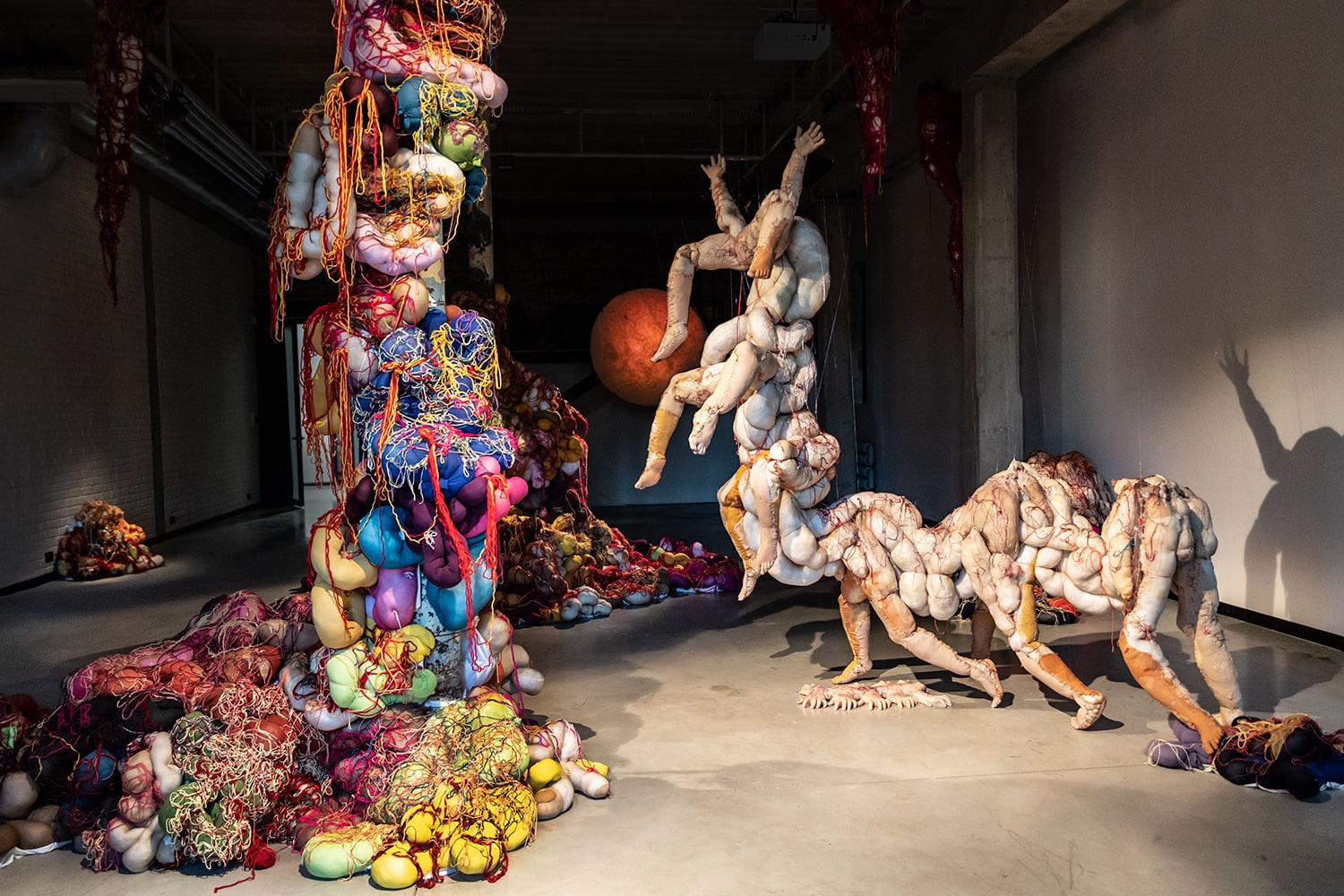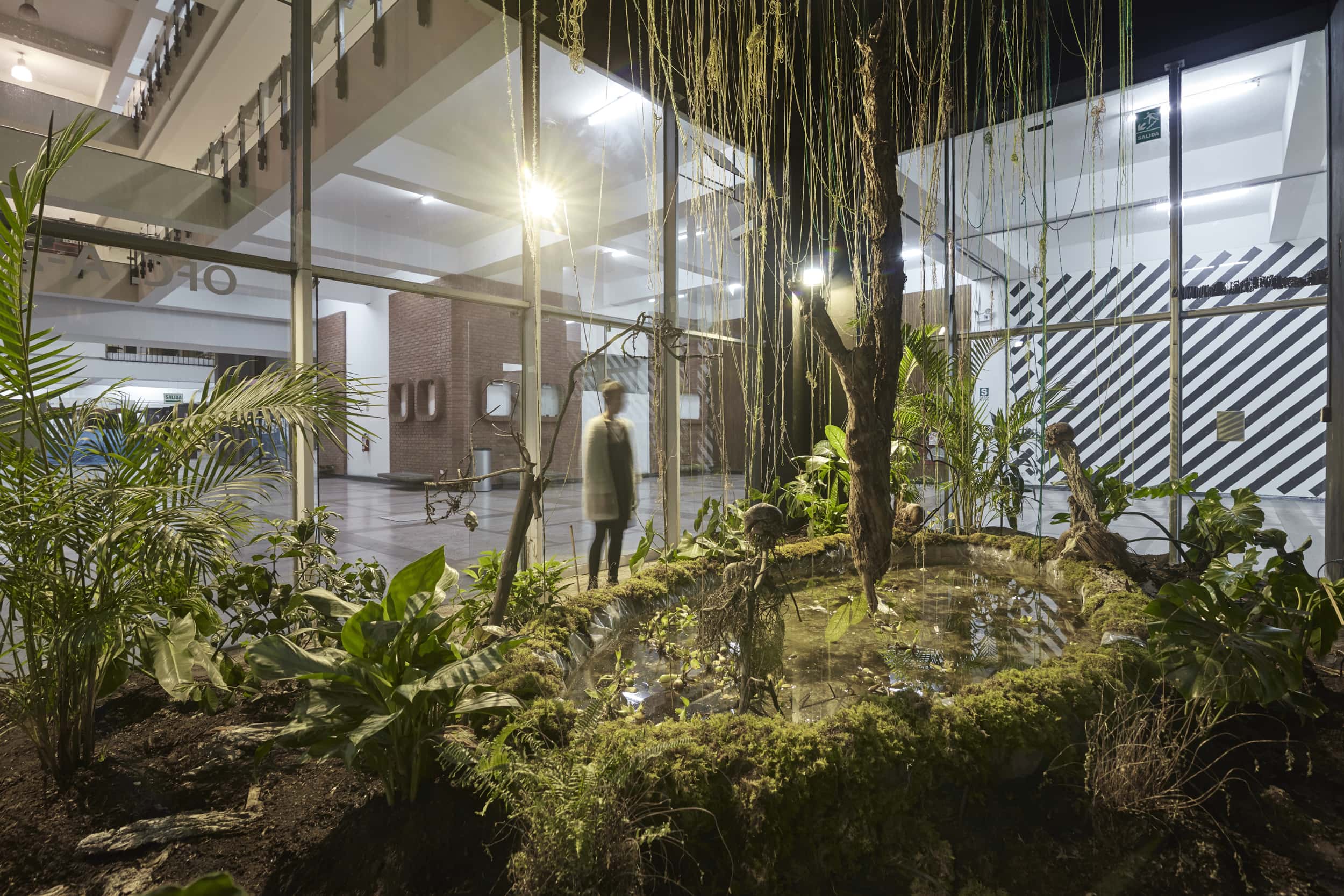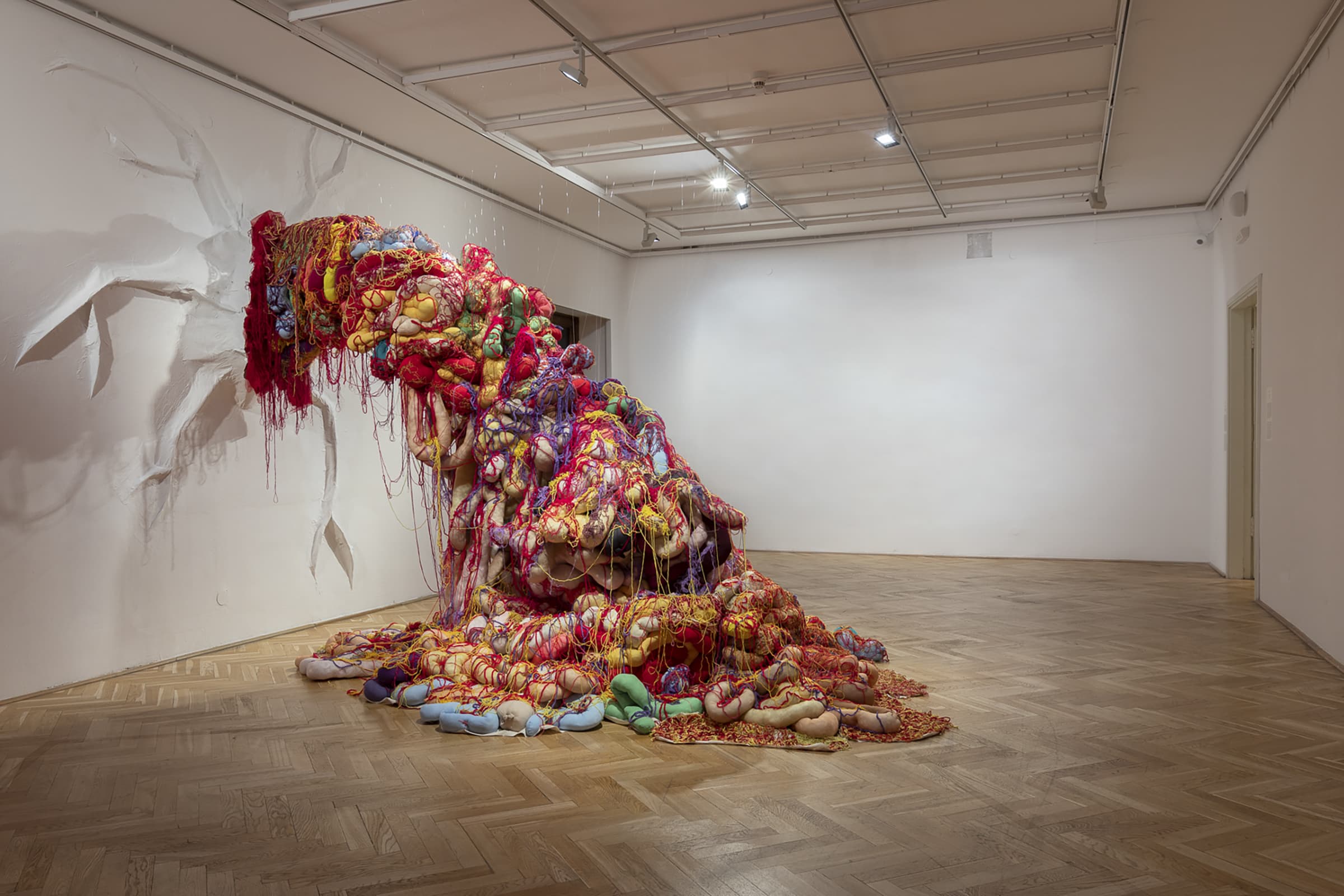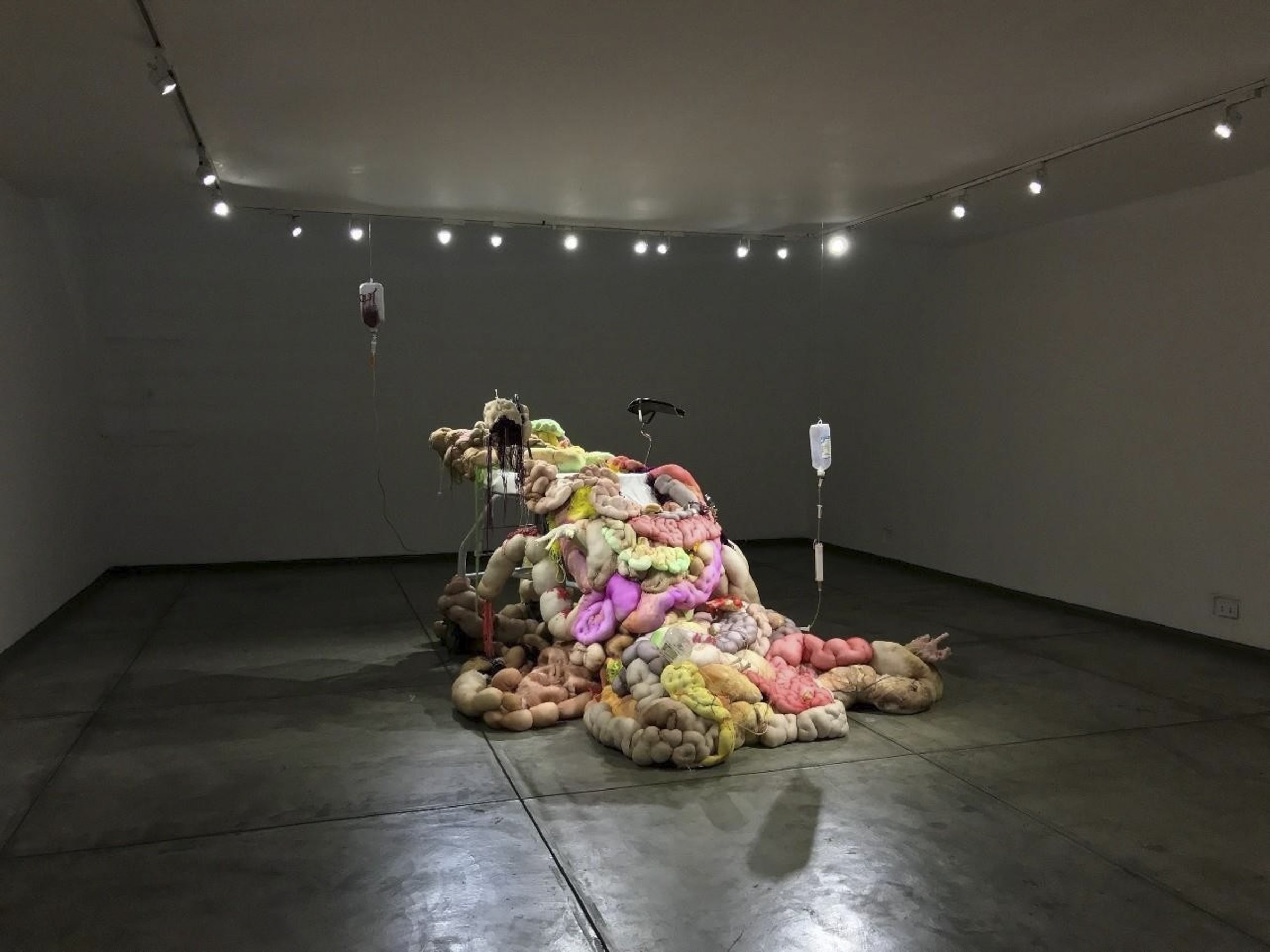
Apocalypse Now: María Abaddón’s Textile Art
María Abaddón’s work revolves around the body or its dissolution. The Peruvian artist creates disturbing environments populated with organs, limbs, and viscera, where the idea of identity comes into conflict.
By Alonso Almenara
María Abaddón’s work revolves around the body or its María Abaddón’s pieces pose a sort of moral puzzle. Those immense fabric structures that envelop the viewer with shapes of viscera and dismembered bodies: do they reflect on the fragility of the human being? Or do they instead reveal a sordid fascination with the very idea of the final catastrophe, the agony, and the putrefaction of those last moments on the path of human destruction?
They could be both at the same time. Born in Lima in the late eighties, Abaddón developed a fondness for Japanese films such as Akira or Tetsuo, the Iron Man, during his youth: films whose cyberpunk aesthetics are imbued with the terror experienced by the inhabitants of the Asian island after the nuclear detonations of Hiroshima and Nagasaki. The mutations and loss of bodily autonomy suffered by the characters in these films, victims of unbridled genetic experimentation, undoubtedly resonate with Abaddón’s imagery. But so do the images of mass graves and car bomb attacks produced during the war between Shining Path and the Peruvian state in the late twentieth century.
“I am also very interested in B-movies,” he comments. “Those violent, low-budget productions like Tokyo Gore Police.” This combination of references, between the gruesome and the lugubriously existentialist, is reflected in the ambivalence of a work that explores the expressiveness of a world without humans or where the human form proliferates already devoid of individuality.
This proposal connects with the visceral style of artists like the Swiss Andrea Hasler, whose sculptures use materials that imitate human flesh, or with the recent installations of the British Anish Kapoor, which evoke vivid images of organs and open wounds. The vestigial presence of the human being is a theme that Abaddón shares, indeed, with other Peruvian artists of his generation, such as Wynnie Minerva and Nicolás Lamas. However, his methods yield original and provocative results: Abaddón almost exclusively uses textile materials, forcing viewers to reconsider what they thought they knew about the ancient traditions that inspire these works.
We talked with the Peruvian artist as he prepares to open his solo exhibition María Abbadón: Paisajes de la destrucción (María Abbadón: Landscapes of Destruction) on July 11 at the Ginsberg Gallery in Lima, curated by Oscar Manrique. His work will also be included this month in two group exhibitions: Color. El conocimiento de lo invisible at the MAC-Lima, curated by María Santoyo and Miguel A. Delgado, and NOW WHAT?! (Drawing Edition) at the British Institute of Miraflores, curated by Fidel Artista.
How do you define your proposal?
I consider my aesthetics a sort of soft gore: I use colors like pink, purple, Nile green, or pastel tones; I also use pillows and plush toys. The pieces are touchable and very soft. Some things I create seem pretty cute to me. I’ve had this throughout my life: since I was a child, I made home decorations and even participated in art projects at my son’s school. However, what I find cute may appear sad or lugubrious to others.
Nevertheless, I’ve noticed that kids are a bit like me these days. They have an affinity for monsters, something that adults, in general, don’t understand. You see them playing with horrifying dolls, and it’s completely fine.
You mention that your sculptures are soft and touchable. Let’s talk about your work process and the materials you use.
I work with textile materials and fibers in general. Sometimes I use branches and things like that. I’ve been working with sheep’s wool lately, and I like it. The result is curious; it’s a very sensory thing.
I have a workshop where I work with several people. It all depends on the project. Small textiles are only possible to do with help. So, some people help me with felting, weaving, etc. But the things I outsource are simple and quickly produced. The great thing about weaving is that you work in small units, but it can become something gigantic through accumulation. After having woven these small pieces, the people who helped me were often surprised by the magnitude of the finished work. It’s like, “Oh, look, this goes here.”
In your work, I’d like to discuss the human figure: we see organs, viscera, but rarely complete individuals. There are only a few whole people.
That’s true. I think I’ve only made two pieces, including faces, a self-portrait, and a portrait of my son. Normally, there are no complete individuals. I’m more interested in inhabiting a space with mixed things. I like the idea that the edges of people are not well-defined. And that’s how I see social groups, too: these islands where everything is mixed up. Several pieces with characters depict scenes resembling a struggle where people are tearing each other apart. But they don’t have a specific identity.
They also don’t have a defined gender. Is that detail important?
Yes. I try to eliminate all elements that might add interpretations beyond the reading of the body in my work. Things like race, identity, gender. But it’s curious because abandoning these aspects doesn’t prevent the messages from eventually falling into those categories. I still establish discourses regarding identity, gender, motherhood, violence, religion, etc. But it doesn’t always have to be so profound. I like the idea of the monstrous body, that you can customize your character like in a video game, and it’s you. It’s not like if you put on one thing, you’re one thing; if you put on something else, you’re something else. You can mix it all up, and that’s it. The situations I propose are a bit like that.

How did you start your journey in art?
I began with quite a bit of resentment towards the art institutions. It’s not a sincere environment, and there’s a disconnection with the popular world. My education was quite traditional. Nevertheless, I feel like I learned quite a lot, and in the end, they taught me to suffer. After graduating from Fine Arts, I dedicated time to cultural management out of pure anger while still working on my pieces. It wasn’t until 2015 that I reconnected with the art scene through the Amil Project, which gave me a workshop where I could see and learn more. I believe that art in Peru is not something that people understand how it works. There are still conversations about what is art and what is not, which were already resolved in the 60s—even academic discussions.
Actually, I haven’t been so interested in creating sellable works. I’m more interested in material exploration, whether it’s preservable or not. And in that process, the bodies lost shape, and the pieces spread everywhere. I explored dimension, volume, and mass and arrived at certain conclusions. Now, I’m doing the reverse, trying to contain the situations and transfer them to other formats. I’m exploring the flat format quite a bit, but in a sculptural way, through felting, weaving, and the loom. Now, I’m in a phase where I’m interested in incorporating more techniques and working with different languages.

Peru has a vast textile tradition. Is it something you take into account in your work?
I would like to learn several things I’ve seen being worked on here. But my interest is mainly technical. I still need to explore history and get to know these traditions thoroughly. For example, this year, I attended burlap workshops, a textile technique used to represent scenes from daily life. I’m also learning to use the loom. I’d like to learn how to dye fibers, but for that, I have to venture more into the territory. The real textile knowledge is not concentrated in Lima, even though great Lima artists work with these materials. One needs to move outside the capital regarding fiber production, dyeing, spinning, etc.
Do you feel connected to other artists in Peru or Latin America?
Right now, I will be part of a collective exhibition at MAC-Lima called “Color. El conocimiento de lo invisible” (Color. The knowledge of the invisible). Among the pieces included, there’s one by Ana Teresa Barboza. I knew her work; she was a reference when I was studying. But what I had seen online were small pieces, not the magnitude of what has been included in the collective exhibition. It’s a giant loom, about seven meters high. It looks like a crust in space. That surprised me. I also recently saw an exhibition by Antonio Páucar at ICPNA, which I found incredible. It’s not precisely textile; he works with hair, braids, and tension knots. He has an installation with flies that blew my mind.

Do you think textile materials are having a good moment in art?
Since 2012, textiles have become more present and have become something ordinary. The thing is, for a long time, it was considered just a craft. And, indeed, it’s not like an oil painting. A loom is a loom; it’s something else. In the art world was given little attention or used so much. It has been a long process. As I was saying, it’s part of those discussions that have happened late in Peru. The same happened with ceramics, retablos, and engraved mates. We come back to the same question: Is this art? Is it craftsmanship? Of course, there are spaces where it’s not felt as much, but they are few. In terms of education, the delay is definitely felt.


